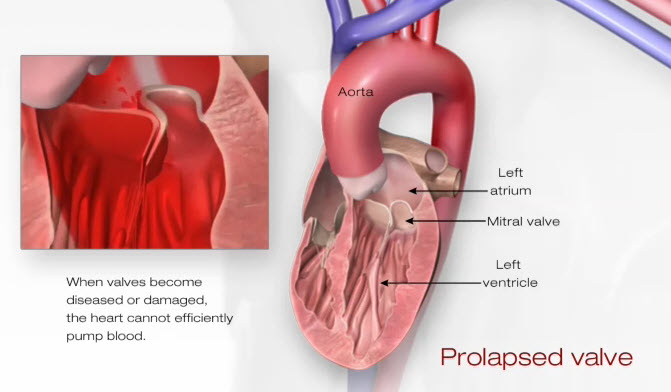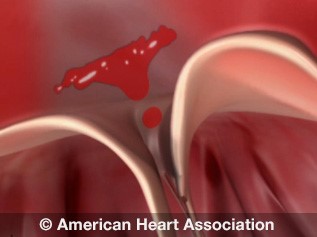Problem: Mitral Valve Prolapse

What's mitral valve prolapse?
Mitral valve prolapse, also called MVP, is a condition in which the two valve flaps of the mitral valve don't close smoothly or evenly, but bulge (prolapse) upward into the left atrium. Mitral valve prolapse is also known as click-murmur syndrome, Barlow's syndrome or floppy valve syndrome.
What happens during MVP?
When the heart pumps (contracts), part of one or both flaps collapse backward into the left atrium. In some cases, the prolapsed valve lets a small amount of blood leak backward through the valve, called regurgitation, which may cause a heart murmur.
Watch an animation of mitral valve prolapse.
Is mitral valve prolapse dangerous?
In most cases, it’s harmless. Most people who have the condition are unaware of it and their health isn't affected. However, in some cases treatment is required.
What causes MVP?
The most common cause of MVP is abnormally stretchy valve leaflets, called myxomatous valve disease. A person can be born with the genetic risk of developing MVP. It also can be caused by other health problems, such as some connective tissue diseases.
How is mitral valve prolapse detected?
Because most patients with MVP don’t have symptoms, a murmur may be detected during a routine physical exam when listening to the heart with a stethoscope. Common symptoms include bursts of rapid heartbeat (palpitations), chest discomfort and fatigue.
What should I do if a murmur is detected?
Even for those who aren’t having symptoms, if a murmur is detected suggesting mitral valve prolapse, an echocardiogram (echo) is recommended. The echo uses ultrasound to evaluate the characteristics of the valve cusps and how much blood may be leaking (regurgitation) from the valve when the heart contracts. Another test may be cardiac magnetic resonance imaging (CMR), also known as cardiac MRI. The test results and extent of your symptoms will guide your health care team in determining if further testing is needed.
Does mitral valve prolapse need to be treated?
In many instances, having MVP won’t impact your health and requires no treatment. Talk with your health care team about how to prevent complications from MVP based on your level of risk. If you’re prescribed medication, take it as directed.
People with an abnormal mitral valve may need mitral valve repair or replacement if:
- Symptoms are getting worse
- Mitral regurgitation becomes severe
- The left ventricle or left atrium of the heart become enlarged
- Arrhythmias develop
- The heart function (ejection fraction) decreases
MVP rarely becomes a serious condition. However, in the most serious cases it can cause abnormal heartbeats (arrhythmias) that may eventually become life-threatening.
When mitral valve prolapse is severe enough to cause significant valve leakage, called “regurgitation,” it can lead to serious complications such as heart attack and stroke. This happens because when the valve leaks, it can cause the atrium to enlarge. An enlarged atrium may lead to heart rhythm problems such as atrial fibrillation, which may cause blood clots to form. When clots travel from the heart to the arteries or the brain, it can lead to a stroke or heart attack.
Know the signs and symptoms of heart attack and stroke.
Do people with MVP need to take antibiotics before dental procedures?
The use of antibiotics before having a dental procedure is no longer recommended by the American Heart Association for people with mitral valve prolapse, regardless of whether they have associated symptoms.






